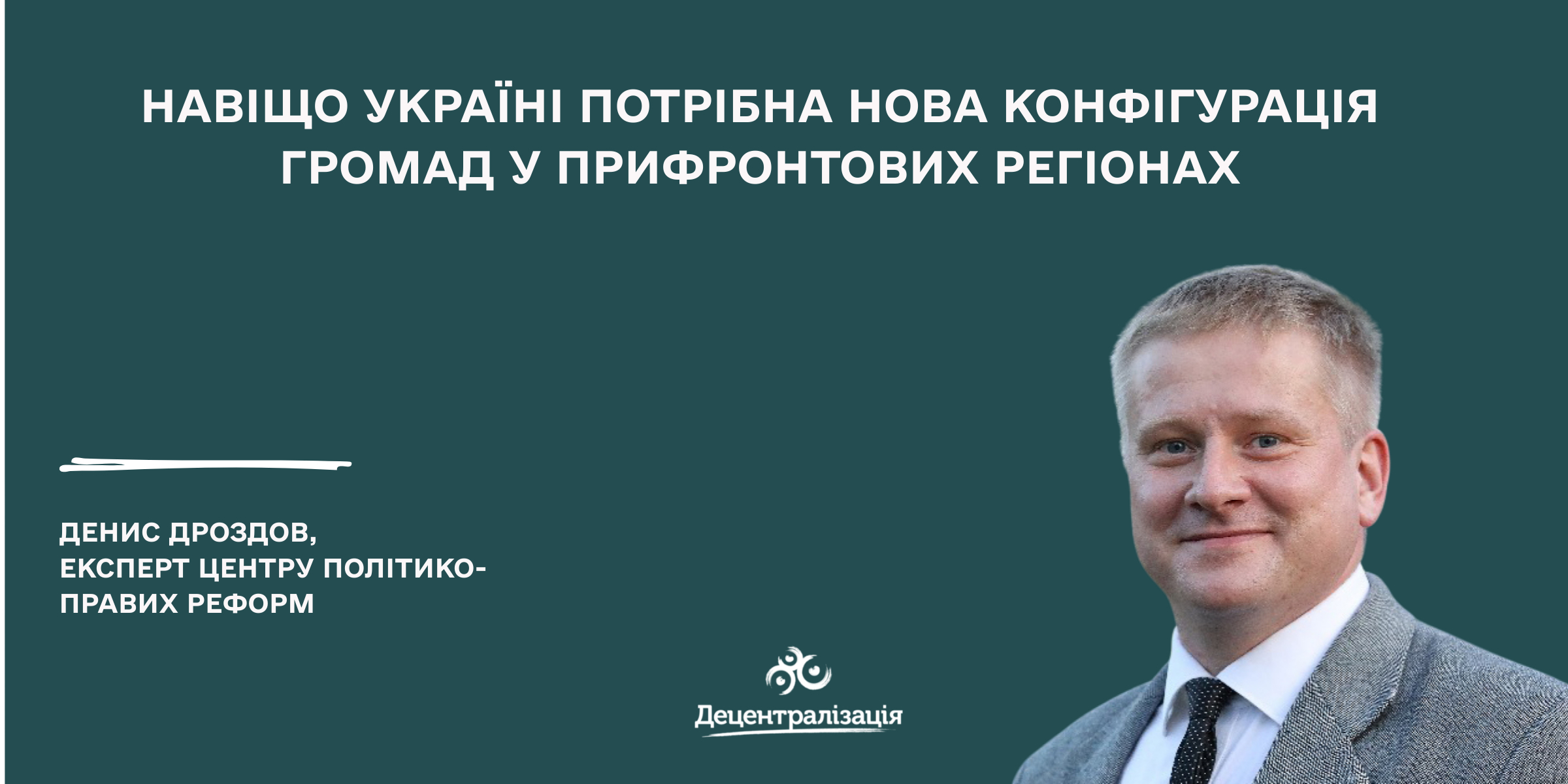Why Ukraine needs a new configuration of communities in frontline regions
Denys Drozdov, Expert at the Centre for Policy and Legal Reforms
Full-scale war has not only destroyed the infrastructure of south-eastern and eastern Ukraine, but also the very logic of how communities function. In many cases, it will be impossible to reinstate the pre-war administrative and territorial structure. A study conducted in spring 2025, titled ‘Justification for the Reconfiguration of the Administrative-Territorial Structure of the Zaporizhzhia, Kharkiv, and Kherson Regions in the Post-War Period’, offers a fresh and pragmatic perspective on the capabilities of these territories and outlines scenarios for the future reform.
Communities in the Donetsk, Zaporizhzhia, Luhansk, Kharkiv, Sumy, and Kherson regions have been hit hardest by the negative consequences of the war. Adjacent to the borders of the Russian Federation and combat zones, these regions are at high risk of repeated attacks, a deteriorating demographic situation, and a further decline in economic potential due to the destruction of economic ties. This requires the administrative-territorial structure of these regions to be reconfigured in order to ensure an adequate level of public services.
‘We are trying to help the state find answers to the question of how to restore territories that are still under occupation, near the front line, or that have already been de-occupied. It is necessary to clearly visualise what the administrative-territorial structure and public authorities in these territories should look like, and to find answers to questions such as where to find personnel for these territories and what to do with them. It is equally important to give a voice to civil society, especially during the transition period when local governments will not yet be operational. Answers to these questions must be sought now by analysing the current situation, modelling its development and drafting regulatory and legal acts to solve specific problems and find ways to overcome them,’ says Oleksii Orlovskyi, Director of the Democracy and Good Governance Programme at the International Renaissance Foundation.
De-occupied, but not capable
Following large-scale destruction, depopulation, mining and changes to the labour force, many communities in frontline regions have lost their ability to function. In most of these communities, there is no one to organise education processes, provide basic medical care or manage public utilities.
While financial support from the state or international community is important, it is insufficient if there are no people physically present in the community who can provide services. When local institutional capacity has been destroyed, maintaining the previous configuration solely for the sake of formal stability can be dangerous.
The current methodology for forming capable communities in a post-war context is ineffective. Indicators such as the tax capacity index, the proportion of local taxes and the structure of personal income tax lose their meaning in areas where economic activity is limited or has ceased due to the war.
‘In de-occupied regions, financial indicators cannot be the only criterion. Human capital becomes the main resource. Without schoolchildren, doctors or teachers, a community has no potential for recovery,’ emphasises Inna Zablotska, author of the study and expert on the project ‘Forming the Conceptual and Legal Foundations for the Effective Post-War Recovery of Ukraine’s De-Occupied Territories’.
New criteria must be based on the current state of affairs
The study proposes a new model for assessing capacity based on three key indicators:
·the number of people,
·the number of students in schools,
·the share of the working-age population that will live in the community.
In addition, the spatial configuration of the territories was assessed, taking into account the number of localities in the community, transport accessibility and territorial integrity. This approach provides a broader perspective, considering not only financial tables but also basic needs and potential for recovery.
At the same time, financial criteria are being standardised because communities that will be restored in destroyed and mined territories are unlikely to be able to fill local budgets independently.
More problems than it seems
The analysis showed that the vast majority of communities in the Zaporizhzhia, Kharkiv, and Kherson regions will not meet even the minimum capacity criteria in 2025. There are no capable communities in the Kherson region and only three out of 67 communities are capable in the Zaporizhzhia region. The situation is better in the Kharkiv region, where 15 out of 56 communities are capable. This indicates that ‘freezing’ the current system without changes will only exacerbate the management crisis.
Problems have also been encountered at district level: fewer than half of the districts meet the NUTS 3 standard in terms of population (between 150,000 and 800,000 inhabitants). Some districts are too small in terms of population, while others have been artificially enlarged. This has an impact on the efficiency of resource allocation, the organisation of medical districts, and logistics and management.
Modelling the future: Three scenarios
For each of the three criteria, the experts modelled three scenarios of population return:
·Pessimistic — 30 per cent return,
·Realistic — up to 70 per cent,
·Optimistic — more than 70 per cent.
This approach enables the authorities and donors to avoid planning ‘blindly’ and instead focus on potential future scenarios. The results of the scenario analysis show that:
·37 out of 172 communities in three regions require spatial changes,
·94 communities can remain in their current form under any scenario.
In total, 135 communities could remain administrative-territorial units in either an optimistic or a realistic scenario.
This provides a clear roadmap for the Cabinet of Ministers and the Regional Military Administrations that are responsible for the reconfiguration.
Kharkiv region is the exception that proves the rule
The Kharkiv region is in a unique situation. An analysis of financial indicators for the period 2021–2024 shows that, even during wartime, one in three communities is demonstrating positive trends and proving its viability. Therefore, it would be inappropriate to include the Kharkiv region in the category of regions where criteria for assessing community capacity are applied to reconfigure the administrative-territorial structure. Flexibility should be maintained here. For instance, rather than using classic tax capacity indicators, dependence on subsidies or the proportion of own revenues could be considered. This approach enables models to be adapted to different conditions without compromising the principles of reform.
Reconfiguration should be a smart reboot
The post-war reconfiguration of the administrative-territorial structure is not just cosmetic editing of the map, nor is it a reason for centralisation. Rather, it is a means of restoring the functionality of local self-government where it has been lost. It is not about ‘consolidation for the sake of consolidation’, but about ensuring basic living conditions, such as access to healthcare, education, logistics and management.
A spatial assessment of the capacity of communities was carried out according to the following criteria: the number of localities in the community; the number of centres of gravity (mono- or polycentric); the distance of localities from the community centre exceeding 20 km; configuration of community boundaries – regular (compact, elongated, star-shaped), irregular (crescent-shaped), presence of enclaves/exclaves; features of community boundaries; natural factors (mountains, rivers, forests), transport and infrastructure factors (roads, bridges). However, the volume and location of destroyed infrastructure were not taken into account.
In both the optimistic and pessimistic scenarios for the Kharkiv region, it is recommended that the number of communities is reduced from 56 to 45, with seven districts remaining unchanged. Meanwhile, only six communities are considered optimal, while 37 require spatial optimisation. A further 13 communities are set to undergo complete reconfiguration, with two new ones to be created.
In the Zaporizhzhia region, the reconfiguration will be on a large scale. In the best-case scenario, the number of communities will be reduced from 67 to 43; in the worst-case scenario, it will be reduced to 42. The most common step is spatial optimisation. Even in an optimistic scenario, 38 communities need to be reconfigured. Twenty-four communities are to be completely reorganised, although no new ones are planned. While this indicates the preservation of a certain management framework, it also shows the deep disintegration of the pre-war community network under the pressure of war. As for the districts, it is proposed that they be reduced from five to three by merging them.
The Kherson region is one of the regions most affected in terms of territorial administration. In the best-case scenario, it loses five communities (falling from 49 to 44), and in the worst-case scenario, it loses as many as 15 communities (falling from 49 to 34). Only one community is considered optimal in both scenarios: the Stanislaviv community in the Kherson district. The remaining communities require serious intervention: up to 40 need spatial optimisation and up to 17 need complete reconfiguration. The demand for the creation of new communities is also highest here (up to three in the optimistic scenario and two in the pessimistic scenario). This indicates the need for an administrative and institutional restart of local self-government. As for districts, it is proposed that they be reduced in number from five to four by merging them.
The study’s proposed methodological approach could serve as a basis for government decisions regarding the updating of district and community configurations in de-occupied and frontline regions.
For people to return, communities must be capable. For this to happen, a new foundation for their formation is needed. This foundation must come from the future, not the past.
The study was conducted as part of the project ‘Forming the Conceptual and Legal Foundations for Effective Post-War Recovery of Ukraine’s De-Occupied Territories’, which is supported by the International Renaissance Foundation. The project is being implemented in cooperation with the All-Ukrainian NGO ‘Association for the Promotion of Self-Organisation of the Population’, the NGO ‘Centre for Policy and Legal Reforms’, the NGO ‘Civic Initiative of Luhansk Region’ and the NGO ‘Association for Revival and Development’.
The column reflects the opinion of its author only. The author is responsible for ensuring the accuracy of the information. The views expressed in the column may not coincide with those of the editorial staff of the Decentralisation Portal.

27 November 2025
Запрошуємо муніципалітети Європи долучатися до...
Заступник міністра розвитку громад та територій України Олексій Рябикін взяв участь у Форумі «Капіталізація та...
27 November 2025
Житомирщина презентувала проєкти розвитку на Impact.Zhytomyr 2.0 Forum
Житомирщина презентувала проєкти розвитку на...
25 листопада у Києві відбувся Impact.Zhytomyr 2.0 Forum – фінальна подія освітньої програми, спрямованої на...
27 November 2025
Проект «Відновлення для всіх» в пошуках Експерта/ки з регіонального розвитку!
Проект «Відновлення для всіх» в пошуках...
Що потрібно буде робити: розробляти у співпраці з Міністерством розвитку громад і територій України практичні...
27 November 2025
Запрошуємо долучитися до Форуму цивільного захисту “Синергія заради безпеки”
Запрошуємо долучитися до Форуму цивільного...
4 грудня у Києві відбудеться Форум цивільного захисту “Синергія заради безпеки”, організований Фондом...
